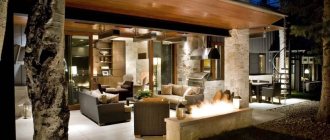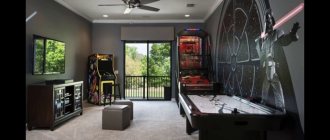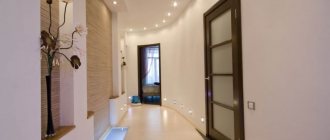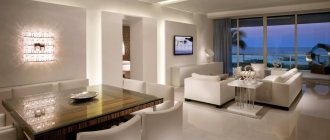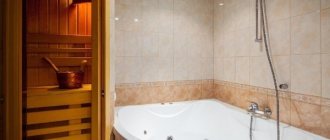Mistakes when choosing lighting for an apartment
It is difficult to create a high-quality lighting project without even a minimal understanding of the system. By throwing yourself into bold design experiments, you can make mistakes that are very costly to correct. Top 7 main shortcomings:
- Lack of a clear lighting plan. If you don’t have a ready-made project on hand, it’s simply impossible to organize a competent system. You risk missing important details.
- Different color temperatures of lamps. Dissonance is inevitable if some of the lamps shine with a warm shade, and others with a cold shade. Such disagreement will visually destroy even the most original interior.
- Incorrect placement of lighting sources. You cannot rely on luck and believe that randomly placed lamps will provide uniform flows of light. It is necessary to analyze possible options and think through placement points.
- Failure to comply with lighting standards. Even if it seems to you that two lamps per room are enough, it is better to double-check your beliefs through calculations.
- Purchasing budget lamps with flicker. When choosing light sources, you should be guided not by price, but by the quality of the products. Lamps with a high percentage of flicker have a bad effect on vision and health.
- Use of diverse lamps. It is necessary that light sources be combined in style. For example, a classic crystal chandelier will look strange against the backdrop of trendy pendant lamps with metal shades. Trends are great, but the compatibility of elements is still more important.
- Ignoring the features of the room. There are proven ways to brighten a dark room. With the help of light you can transform even the darkest and cramped room.
In this article we will touch on all of the above aspects. Design tips will help you avoid mistakes and create a stunning atmosphere in your rooms.
Advice! Do not blindly repeat the lighting design that you saw in a picture on the Internet or from friends. You need to first check whether it will fit into the interior of your home.
Adding light sources
One of the most effective ways to make a room brighter is to provide it with thoughtful artificial lighting. Replace yellow incandescent lamps with cold, energy-saving ones, leaving warm light for the bedroom or evening relaxation in the living room.
Add a table lamp, floor lamp, diode strip or even a garland - no new wiring is required, and the room will become more comfortable.
Types of lighting
Room lighting is divided into two types: natural and artificial. It is difficult to imagine one without the other, because they are interconnected and equally important. Let's look at the main features of each type.
Natural
Natural light enters the room in the form of sunlight. It is comfortable for vision, has no flicker, and provides ideal color rendition. Such lighting is vital for the inhabitants of the house.
The sun's rays can enter a room in different ways. Three types of natural lighting organization:
- Lateral, when light enters the room through windows on the walls.
- Upper, when the rays penetrate through the openings in the roof.
- Combined, when light enters the room through openings in the walls and roof.
According to SNiP 23 – 05 – 95, which regulates lighting standards in residential premises, it is important to receive natural light for at least 2.5 hours daily. Some rooms especially need sunlight. For example, kitchen, living room, children's room. It is worth considering this fact when creating a design project for an apartment or house.
Important! The optimal type of natural lighting in your home is combined. In apartments, it is most often possible to implement only the side one.
Overhead natural lighting in the bedroom
Side natural lighting in the dining room
Combined natural lighting in a private house
Artificial lighting
Artificial light - radiation fluxes from lighting devices. In the dark, this is a successful replacement for the sun's rays. The better the artificial lighting is organized, the more comfortable it is to be in the rooms.
Types of lighting devices:
- Chandeliers.
- Lamps, spots.
- Sconce.
- Floor lamps.
- Desk lamp.
There are standards and requirements for indoor lighting. These are the ones you need to rely on when developing a lighting design plan.
Example of artificial room lighting
Selection of lamps
For residential premises, first of all, you should choose the right lamps.
A lamp (lighting device) includes a light source (lamp), a socket for connecting the lamp to the electrical network, reflectors, lampshades, ballasts and devices for attaching the lamp to the surface of the ceiling or wall. A significant role in the choice of lamps is played not only by their lighting characteristics, but also by their appearance, and of course, the type of light sources used. For lighting residential premises, incandescent lamps (including halogen lamps, an improved version of incandescent lamps) and compact fluorescent lamps are most often used. The main characteristics of various light sources are given in the article “Lighting - choosing light sources.” When designing lighting in various administrative and industrial buildings, the designer selects lamps strictly from those permitted for a given type of room. There are no strict restrictions when choosing lamps for lighting an apartment. For the home, as well as for some office and industrial buildings, lamps can be selected and purchased in online stores, the official websites of which you can see on the Lamps Stores website page.
Different lamps that provide a given illumination in a room may have different emitting surface areas. In this case, the larger the area of the emitting surface, the lower the luminous flux density on the emitting surface of the radiation source, defined as lm/m2. This parameter is often called luminosity. To ensure that the lamp does not have a blinding effect, they try to increase the emitting surface of the lamps using shades. Or they design the diffusers and reflectors of the lamp in such a way that the luminous surfaces of the lamps do not fall into the field of view. Of course, the ideal diffuser is a white ceiling with a high reflectivity.
Currently, unfortunately, attempts are being made in Russia to abandon incandescent lamps due to their low energy efficiency (the ratio of the luminous flux emanating from the lamp to the electrical power consumed by the lamp). But so far they have been offered practically nothing in return. All available light sources are inferior to conventional incandescent lamps (and halogen lamps, respectively) in terms of spectrum quality. In incandescent lamps, light is emitted by a heated filament (tungsten filament) and has a very uniform spectrum. And thanks to the high inertia of the heated lamp coil, there are virtually no illumination pulsations. In addition, the luminous flux of incandescent lamps is easy to regulate with special regulators - dimmers, which look like a regular switch.
Another feature of incandescent lamps is the proximity of their spectrum to the spectrum of sunlight in the morning and evening hours, when the blue component of the spectrum is minimal. The predominance of the blue component in the spectral composition of lamps can in some cases cause harm to health. For more information on the potential harm of high levels of blue light in the spectrum of light sources, see the article “Lighting - Lamp Spectrum Requirements.”
In public buildings, in accordance with the Sanitary rules and regulations governing hygienic requirements for lighting SanPiN 2.2.1/2.1.1.1278-03 (as amended and supplemented on March 15, 2010), incandescent lamps when designing lighting are allowed to be used only for lighting premises in institutions preschool, school and vocational education (clause 3.1.5). Also in the main functional premises of medical institutions. That is, only where, despite significantly increased energy consumption, it is necessary to create maximum comfort for the eyes. In the same rooms, lamps with fluorescent lamps can be used. For fluorescent lamps used in residential premises, it is necessary to use electronic ballasts (ballasts), which can significantly reduce light pulsations compared to electromagnetic ballasts.
In recent years, LED light sources have become widespread. But, in accordance with the SanPiN mentioned above, quite significant restrictions are imposed on them: in residential and public buildings, lighting devices with LEDs must have a protective angle that excludes direct radiation from entering the field of view (clause 3.1.5). That is, the lampshades and diffusers of the lamp must be such that we cannot see the luminous surface of the LEDs itself. Otherwise, LED lights may cause significant glare. Since the very small surface of the LED is capable of creating a significant luminous flux. In addition, some cheap LED lamps containing the simplest control devices have an unacceptable light pulsation coefficient, reaching up to 80%. If you illuminate an apartment with lamps with such a coefficient of illumination pulsation, then after an hour of reading your eyes will feel tension and fatigue. And children's performance at school will go downhill.
The spectrum of many LED light sources has distinct peaks and valleys. In addition, the luminaires can use LEDs, which are not designed for use in lighting fixtures, but for illuminating advertising banners. There are no high requirements for the spectrum of such LEDs.
The closest thing to incandescent lamps in terms of the quality of the emitted spectrum are fluorescent lamps with multilayer phosphor. The color rendering index of tubular lamps with five or more layers of phosphor can reach a value of 90 and even 95. Such lamps are labeled as 927, 930, 940, 950. Here, the number 9 indicates a color rendering index equal to or greater than 90. And the second and third numbers indicate lamp color temperature: 27 - 2700 degrees Kelvin, 30 - 3000 degrees and so on.
Color temperature and color rendering of light
An important factor in choosing lamps for lighting rooms is color temperature. This indicator illustrates the quality of light and the shade of the glow. The unit of measurement is degrees Kelvin (K).
Color temperature information can be found on the packaging of the light bulbs you purchase. To make it easier to understand, consider three types of glow:
- Warm - 2700 K. Soft light with an unobtrusive yellowish tint.
- Neutral - 4000-4200 K. Light as close to natural as possible.
- Cold - 6000-6400 K. Glow with a slight bluish tint.
Important! There are lamps with parameters much higher than 6400 K, but they are not suitable for residential premises.
The shade of the glow directly affects the psycho-emotional state. Warm light is perceived best - it gives comfort and tranquility. This shade is suitable for general lighting. Neutral is more often used to highlight local zones. Cold light is often found in offices, home libraries, hallways, and hallways.
Many people confuse color temperature with color rendering index. However, the second indicator does not symbolize the tone of the lamp's glow, but the ability of light rays to distort the shades of surrounding objects. To evaluate the index, a numerical scale with numbers from -60 to 100 is used. The higher the lamp index, the more correctly the real colors of objects will be recognized when the light is on.
Full scale of light color temperature
Electrical wiring design and diagram
The distribution of light in an apartment or house should begin with the development of an electrical wiring plan. It is important to think about where lighting fixtures, sockets and switches will be located. All this needs to be reflected in the diagram.
To create a diagram, you don’t have to use special programs or make complex drawings - just arm yourself with colored pencils and a sheet of paper. It is necessary to sketch out the apartment plan as accurately as possible: indicate the location of rooms, corridors, ceilings.
Once the housing plan is ready, you can begin distributing appliances. The first thing you need to note is the location of sockets and switches. Some tips for placing them:
- Sockets can be placed on any wall at a distance of at least 15 cm from door and window openings. It is worth retreating at least 40 cm from gas pipelines and batteries.
- According to the standards, there must be at least one socket per 6 m2 of room. If necessary, you can install more elements.
- Switches are usually located to the right of the doorway at a distance of 60-150 cm from the floor. However, options are possible depending on the type of room.
After the designations of sockets and switches appear on the diagram, it is necessary to indicate the routes for laying the cables. They must run strictly in a straight line horizontally or vertically. If you plan to lay wires inside walls, mark 15-25 cm clearances from doorways and ceilings.
Important! It is also necessary to indicate in the plan where the distribution boxes and panels will be located. They are not always located indoors, but they must be present in the diagram.
Apartment lighting plan
Lighting design is the next step after planning the purpose of rooms and arranging furniture. Many people mistakenly believe that one chandelier in a room is enough. However, in this case, local areas of the room will remain darkened. To prevent this from happening, three types of lighting should be included in the project:
- General: ceiling lights, lamps, chandeliers for uniform lighting of the space.
- Local (local, working): lamps for lighting the functional areas of the room.
- Decorative: light sources for decorating interior items and creating a creative atmosphere in the room.
When planning lighting, you should be guided not only by personal preferences. It is necessary to correctly calculate the number of lamps per room area and think about the location of lighting fixtures.
Scenario for proper room lighting
Let's break it down: what should the lighting power be?
Many of us don’t even think about why we feel calm and comfortable in one room, while in another we experience discomfort and anxiety. The atmosphere in a room depends largely on the lighting. Dimmed light helps a person relax and sets the mood for rest, while bright lighting promotes increased activity and increases performance. Situations often arise when in an already renovated and equipped room there is a lack of lighting. If you approach the issue wisely, you can solve the problem without making drastic changes to the interior.
When planning to improve the lighting in a room, first of all calculate the optimal luminous flux power.
For premises with different functional purposes, there are established standards:
- bedroom – 10-12 W per m² of area (for LED lamps 1.5-2 W per m² of area);
- bathroom, kitchen, study, children's room - 15-18 W per m² of area (for LED lamps 2-3 W per m² of area);
- living room - 20 W per m² of area (for LED lamps 2.5-3.5 W per m² of area).
Calculate the total power of the light bulbs built into the chandelier or lamps and compare with the recommended value. Perhaps installing brighter light sources is enough to solve the problem. Today, devices that operate on the basis of LED lamps are especially popular. Such models consume a small amount of electricity, while producing a powerful luminous flux. LEDs do not contain harmful substances, do not require special disposal, and have a huge reserve of work. LED lamps, like Arte Lamp Mattino A9442LM-12CC, are much more practical than their analogues.
In a dark room, every effort should be made to improve natural light. For this purpose, we recommend removing thick curtains and choosing translucent curtains for the room. Mirrors will also help multiply the amount of light - this is an effective and simple way.
Back to Contents
Plan for placing lamps in rooms
There are basic rules for placing light fixtures, but you can get creative. For inspiration, we offer several ideas and interesting models of lighting devices for different rooms.
Living room
The layout of lighting fixtures depends on the presence or absence of a chandelier. If there is one, it is better to place it in the center and surround it with built-in lamps.
Examples of luxurious chandeliers for a unique interior: Terzani Volver and Luce Tavere .
buybuy
Terzani Volver chandelier in silver
buybuy
Luce Tavere chandelier with several lamps
If there is no chandelier, the task of main lighting falls on pendant and spotlights. They can be arranged in rows, in a semicircle, crosswise, or in a checkerboard pattern. The choice of scheme will depend on the number and type of devices.
You can place sconces or decorative LED lamps on the walls. Don't forget to highlight the space near the sofa or armchair where you most often relax with light.
Example of a living room lighting scenario
Children's
Do not oversaturate the nursery with bright light. One chandelier, 3-4 lamps and an original night light are enough. Table lamps with shaped lampshades will look great on the bedside table.
Example of a living room lighting scenario
Idea! Using a projector, you can “strew” the ceiling with stars. This decorative lighting option will definitely impress children.
Bathroom
If you don't know how to position the lights in the bathroom, feel free to plan a three-level lighting system. We decipher: the upper level is ceiling lamps, the middle level is sconces, the lower level is LED strip or miniature spots for floor lighting.
Increasingly, designers are decorating bathrooms with original pendant lamps. Such products look especially interesting near mirrors or wall cabinets. The most advantageous composition is two symmetrically located lamps.
Examples of lamps: the laconic Paulmann and the ultra-fashionable Artichoke Red .
buybuy
Paulmann pendant lamp
buybuy
Pendant lamp Artichoke Red
Example of a bathroom light scenario
Bedroom
For a small bedroom, a chandelier, several sconces and a table lamp are enough. It is better to place wall lamps on both sides of the bed, above the nightstands, near pictures and mirrors. Interesting options for the bedroom: red Turbolamp Laenburg model .
buybuy
Pendant lamp Turbolamp
buybuy
Pendant lamp Laenburg
Example of a bedroom lighting scenario
Kitchen
In the kitchen, built-in lamps can be located on the ceiling and furniture facades. The chandelier will be replaced by stylish pendant lamps in unusual shades. They are best placed above a bar counter or table.
The kitchen apron can be decorated with LED strip. The result will be decorative and at the same time functional lighting in the work area of the room.
Example of a kitchen lighting scenario
Placement of lamps
In residential premises, a large number of lamps are rarely used and, as a rule, their placement does not cause difficulties. Chandeliers are usually hung in the center of rooms. On some walls (in the living room next to the sofa, in the kitchen above the table) wall lamps are installed - sconces. There are also separate zones on the ceilings in which lamps are installed. Moreover, in the selected areas, the ceiling, as a rule, is made with a height difference. For example in Fig. Figure 1 shows the wiring plan for the apartment's lighting network.
Apartment lighting plan
Rice. 1 Apartment lighting plan
(in this picture: 1 – kitchen, 2 – bathroom, 3 – toilet, 4 and 5 – corridors, 6 – hall, 7 – dressing room, 8 – bedroom, 9 – balcony)
Some lamps can be tied to furniture. Therefore, before planning the placement of lamps, all issues regarding the selection and placement of furniture are often resolved. Then design drawings are made with precise connections of lamps and some switches in relation to the building structures of the premises. This particularly applies to bedside sconces in bedrooms. For example, in room 8 in Fig. 1, two sconces should be positioned symmetrically relative to the bed, and switches should be installed above the bedside tables. Without precise references, electricians will not be able to determine the desired placement locations for these wall lights. Therefore, before laying cables to them, it is necessary to know the dimensions and exact placement of the bed in the room.
Electrical wiring plans are carried out in accordance with GOST 21.608-84. The normative document has been in force for more than 30 years. Currently, the standard has been revised and is in the approval stage. When designing lighting for apartments and residential buildings, some simplifications in the projects are allowed, for example, the standardized illumination in the premises is not indicated.
If the apartment is planned to have some architectural elements on the ceilings that have height differences, for example as shown in Fig. 2, then before installing them you should decide on the locations for installing the lamps in them. The shown semicircle with five spotlights is installed in room 6.
Semicircle with lamps
Rice. 2 Semicircle with lamps
Structures for installing lamps must be assembled so that the guides for fastening plasterboard sheets do not interfere with the installation of lamps. The design with lamps shown in Fig. 2 before covering it with plasterboard is shown in Fig. 3.
Design for installation of lamps
Rice. 3 Design for installation of lamps
As you can see in the photo, none of the guides interfere with the installation process of the lamps. A similar semicircle with lamps in kitchen 1 was previously shown in the article Kitchen lamps.
If there is a need to install lamps inside furniture (for example, in a closet), then it is necessary to take into account all the requirements of GOST R 50571.7.713-2011 and clause 559.5 of GOST R 50571.29-2009. First of all, it is necessary to select lamps whose body temperature in normal mode does not exceed 90°C (with a short circuit no more than 115°C). If there is a danger of fire in a confined space, then a lock is installed on the door that disconnects the lamp from the network when the furniture door is closed. It is also necessary to take into account the fire resistance of materials at the installation site of the lamp and on surfaces exposed to heat.
How to make lighting in a room: night and decorative lighting
You shouldn’t give up on effective lighting, even if your plan didn’t include additional lighting. Let's consider two scenarios: decorative and night lighting.
Decorative lighting
Beautiful designer interiors often feature creative lamps, bright neon signs, original lamps, LED strips, and garlands. With the help of these elements you can create an amazing ambience in the room and transform the atmosphere.
It is necessary to think about how to organize decorative lighting in a house or apartment. The main thing is to correctly build the layout and connection of the lamps to the electrical network. Devices must exist independently from the main lighting sources so that they can be turned on separately.
Example of decorative bathroom lighting
Night lighting
It is not safe to move around the rooms at night: in the dark it is easy to trip over furniture or trip. To make moving around comfortable, it is worth providing special lighting. For example:
- LED lighting of the floor, stair steps and flights.
- LED ceiling lighting.
- Wall lamps, floor lamps.
- Night lights and table lamps.
Ideally, you don’t have to reach for the switch to turn on the night lighting. You can set up a smart light system and control devices using voice commands or a remote control. Another convenient solution is to automatically turn the lights on and off. To implement the idea, motion sensors should be integrated into the room. They will react to human movements and start the process of turning on the light.
Many people confuse night and decorative lighting. This is not entirely correct. Yes, both scenarios are considered minor. However, the task of the night one is to ensure safety, and the decorative one is to create a spectacular environment.
Night lighting in the hall
Shadows from lamps: decorative effect or disadvantage
Designers classify decor with shadows as a type of creative lighting. To create fancy patterns on the wall, just choose lamps with perforated lampshades. Light streams will penetrate through the holes and softly scatter across the surface.
Another important aspect of a home shadow theater is the background where the reflection will fall. If it's dark, it won't have a stunning effect. Shadows look beautiful only on a light, monochromatic surface.
Let's look at the situation from the other side. The shadow of a low-lying pendant lamp falling on a table or bar counter is unlikely to delight. Therefore, when creating a scenario, consider suitable locations for the location of light and shadow sources.
Chandelier shadows as a decorative element
